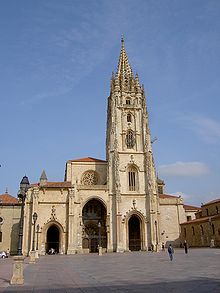Cathedral of San Salvador, Oviedo
| Cathedral of the Holy Saviour Catedral de San Salvador (Spanish) |
|
|---|---|

Façade of the cathedral.
|
|
| Basic information | |
| Location | Oviedo, Spain |
| Geographic coordinates | 43°21′45.30″N 5°50′35.09″W / 43.3625833°N 5.8430806°WCoordinates: 43°21′45.30″N 5°50′35.09″W / 43.3625833°N 5.8430806°W |
| Affiliation | Roman Catholic Church |
| Country | Spain |
| Ecclesiastical or organizational status | Cathedral, Minor basilica |
| Heritage designation | World Heritage Site |
| Leadership | Archbishop Jesús Sanz Montes |
| Website | Official Website |
| Architectural description | |
| Architect(s) | Rodrigo Gil de Hontañón |
| Architectural type | Church |
| Architectural style | Gothic, Romanesque, Baroque, Renaissance |
| Groundbreaking | 9th century |
| Direction of façade | O |
| Type | Cultural |
| Criteria | ii, iv, vi |
| Designated | 1985 (9th session) |
| Parent listing | Monuments of Oviedo and the Kingdom of the Asturias |
| Reference no. | 312 |
| Extensions | 1998 |
| State Party | Spain |
| Region | Europe and North America |
The Metropolitan Cathedral Basilica of the Holy Saviour or Cathedral of San Salvador (Spanish: Catedral Metropolitana Basílica de San Salvador, Latin: Sancta Ovetensis) is a Roman Catholic church and minor basilica in the centre of Oviedo, in the Asturias region of northern Spain.
The Cathedral of San Salvador of Oviedo today displays an array of architectural styles, from Pre-Romanesque to Baroque, including Romanesque, Gothic and Renaissance parts. It began as a large Pre-Romanesque basilica in the present location of the Gothic cathedral, but nothing more is known about that first building, built by order of King Alfonso II of Asturias.
The Cathedral was founded by King Fruela I of Asturias in 781 AD, and enlarged in 802 by his son Alfonso II of Asturias known as Alfonso the Chaste, who made Oviedo the capital of Kingdom of Asturias, and resided in Oviedo with his court. He created the See of Oviedo in 810. The present edifice was begun by Bishop Gutierre of Toledo in 1388, and the tower added by Cardinal Francisco Mendoza de Bobadilla in 1528.
The Cathedral was restored in the 12th century by Archbishop Pelagius of Oviedo, the chronicler. Bishop Fernando Alfonso (1296–1301) undertook another restoration of the chapter-house, and his successor, Fernando Alvarez (1302–1321), began the cloister. At the end of the 13th century Gutierre de Toledo began the new Gothic basilica, the principal chapel bearing his arms, though it was completed by his successor Guillén. Diego Ramirez de Guzmán (1421–41) built the two chapels of the south transept (now replaced by the sacristy), the old entrance to the church, and the gallery of the cloister adjoining the chapter-house. Alonzo de Palenzuela (1470–85) completed the other part of the transept. Juan Arias (1487–97) left his cognizance, the fleur-de-lys and four scallops, on the nave. Juan Daza (1497–1503) erected the grille of the choir; Valerano (1508–12) added the stained-glass windows. Diego de Muros, founder of the great college at Salamanca known as the Oviedo, had the crestings of the porch wrought by Pedro de Bunyeres and Juan de Cerecedo, while Giralte de Bruselas and Juan de Balmaseda completed in the years 1512 to 1517 the carving of the precious altarpiece ordered by Valeriano Órdoñez de Villaquirán. Cristóbal de Rojas (1546–56) affixed his coat-of-arms to the completed tower, with its octagonal pyramid, one of the marvels of Gothic architecture.
...
Wikipedia
